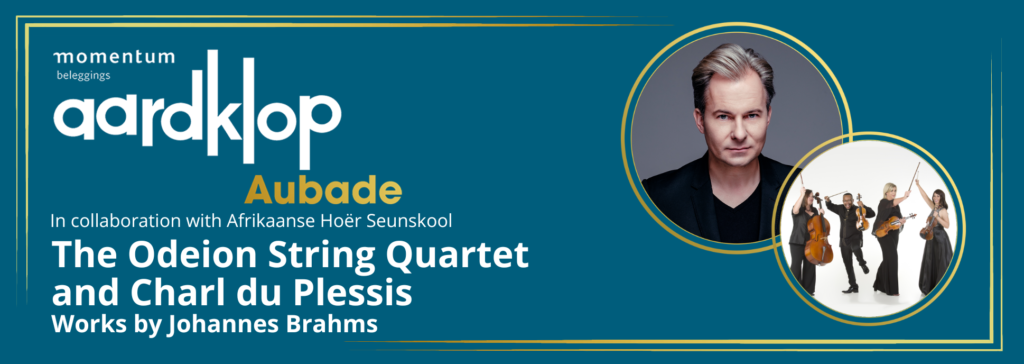Aardklop Aubade in samewerking met Afrikaanse Hoër Seunskool bied aan: The Odeion String Quartet and Charl du Plessis perform a programme of major chamber music works by Johannes Brahms
String Quartet No.1 in C minor, Op.51
I- Allegro
II- Romanze: Poco adagio
III- Allegretto molto moderato e comodo
IV- Allegro
This evening the Odeion String Quartet commemorate Brahms’ 125th anniversary with his finest chamber music. The musical manner that Brahms adopted as a young man, and the skill that he showed when he was only twenty, led Schumann to proclaim him, in 1853, “a musician chosen to give ideal expression to his times, a young man over whose cradle Graces and Hero have stood watch.” From the very beginning, he was the Brahms of noble melody, of rich texture, of rhythmic freedom, of large statements in big forms beautifully written for the instruments. However, if there was one great figure in Western Art music that Brahms revered more than any other, that figure was Ludwig van Beethoven. Brahms was forty, after as many as 20 discarded string quartets, before he finally published his first string quartet, the genre that his towering predecessor had dominated. The first public performance of the string quartet was given by the Hellmesberger Quartet in Vienna on December 11, 1873.
There is a remarkable coherence to the thematic material that informs the C-minor Quartet. Analysts have demonstrated that a single kernel is the source for the themes of the opening and the closing movements. In the Allegro, first movement, the sudden upward rush that opens the work sets the mood for a movement that has been called “robust and sentimental.” The intensity subsides for some lyrical interludes, but the turbulent mood soon returns. The development section transforms the movement’s opening pulses into a mere harmonic flutter before the heavy lifting begins and the themes of the exposition are maneuvered about at close quarters in invertible counterpoint. The recapitulation is remarkable for its coda, an intense agitation of sforzando accents that pulls back in its final bars to end with a written out ritardando in the major key.
The second movement, which is designated as a Romanze, has a restrained, pensive quality. The close spacing of the string writing and restrained dynamic range add to the feeling of intimacy in this movement, which alternates between a warmly expressive opening theme, cushioned with melodic variation at its second occurrence, and a slightly more heart-fluttering middle section featuring pleading groups of sigh motives. In the third movement, the place for the scherzo, is taken by a movement in the traditional form, Allegretto molto moderato e comodo, but with none of the original Italian meaning of the name which is “joke.” It is music that may be interpreted as a gracious dance or as an uneasy, sinister, shadowy one. The contrasting central trio section, Un poco più animato, is a folk-like tune avidly accompanied by jaunty string crossing sounds from the second violin and later from the viola.
The fourth movement begins with an aggressive restatement of the climbing motive that opened the first movement, with its dramatic downward leap of a diminished 7th. So tightly argued is this sonata-form movement that its development and recapitulation sections seemed inseparably grafted together. While moments of soaring major-mode lyricism appear between the clouds to bring spiritual uplift to the argument, especially in the second theme, what remains in the ear after the final coda is the cello’s low C at the bottom of the string register, anchoring this work emphatically in its opening tonality of C minor.
Interval
Piano Quintet in F minor, Op.34
I- Allegro non troppo
II- Andante, un poco adagio
III- Scherzo: Allegro
IV- Finale: Poco sostenuto – Allegro non troppo – Presto, non troppo
The combination of string quartet and piano makes the piano quintet a singularly powerful ensemble as it joins two self-sufficient forces in a grand partnership. This evening is no exception as the award-winning Odeion String Quartet join forces with one of South Africa’s foremost pianists, Charl du Plessis. As a genre, the piano quintet occurs frequently in the repertoire, with some noteworthy examples amongst the works of several of the greatest composers, including Schumann, Franck, Brahms, and Dvořák, all of which the Odeion String Quartet have presented in concert. Brahms’s one and only piano quintet, his Piano Quintet in F minor, op. 34, underwent several metamorphoses before it arrived at its current form. It began life in 1861 as a string quintet with two cellos, but Brahms’ friend and chamber music collaborator, Joseph Joachim, persuaded him that the string ensemble did not do justice to the work’s musical climaxes and symphonic conception. Brahms then switched to the keyboard and rewrote the piece as a sonata for two pianos. With double piano resources he could achieve a more orchestral breadth of sound but he remained dissatisfied with the absence of string colour and eventually he settled on the present version for piano quintet which he published in 1865. A dark, mighty work of tremendous scope, it is generally considered to be Brahms’ great chamber music epic completed when he was only thirty-one.
The first movement is predominantly sombre and tragic. It opens with an eerie unison of piano, violin, and cello that is soon reiterated by the entire quintet in a powerful and painful way that represents the ‘Sturm und Drang’ frequently employed by Brahms in his dramatic compositions. The whole first movement is derived entirely from this first theme. Brahms’s gift for thematic variation and his skill with rhythmic complexity – particularly his use of two beats against three which makes for a driving pulse with a myriad of cross-rhythms – provide a broad and powerful scope to the movement and set the tone for the work as a whole. The full contrapuntal resources of the string quartet are combined with a rich variety of piano techniques to create a density of texture.
The second movement is written with Schubertian lyricism, expressed through the calm grace of the piano which is accompanied by the gentle swaying of the strings. The prevailing tenderness occasionally reveals a hidden sadness. Towards the end the quartet takes the opening song of the piano, and reveals it in a quieter, more reflective mood. This movement forms a sweet intermezzo between the contrapuntal complexity of the first movement and the temperamental quality of the third.
The Scherzo is one of Brahms’ most electrifying compositions. It contains three motivic elements: a rising theme of vague rhythmic identity; a snapping motif in strict, doubled rhythm; and a march-like strain in full chordal harmony. These three components are juxtaposed throughout the movement, with the doubled-rhythm theme being given special prominence in a vigorous fugal workout. The middle section transforms the march into a majestic and powerful chorale. After this ‘Trio’ section, the movement then returns to the maniacal opening themes, and closes in an aggressive and decisive manner.
The finale has a structural composition that is unique to Brahms. It opens with a haunting introduction that becomes more dramatic until the tension is released with the Allegro non troppo section. Here the cello plays the first theme – a folk-like melody that develops into a gypsy dance. Brahms interweaves several themes throughout this movement: the folk-like melody, the rustic dance, and a meditative refrain. His genius in writing variations is exquisitely demonstrated in this movement by the way he morphs and blends the themes together, culminating in a breathtaking coda that sweeps the work to a dramatic end. © Elizabeth Dalton
Venue: Afrikaanse Hoër Seunskool, Pretoria
Date: Sunday, 6 November 2022
Time: 11h00
Tickets: R190, R150 (pensioners), R100 (learners)
Tickets at: www.ticketpros.co.za





